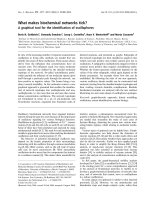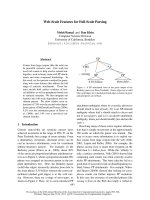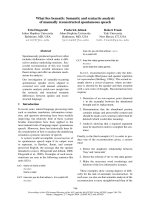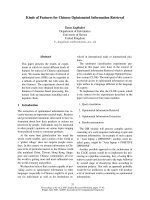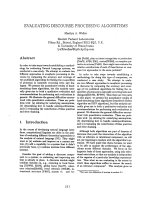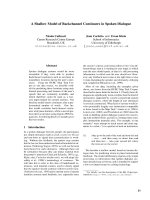Báo cáo khoa học: "WHAT DISCOURSE FEATURES AREN''''T NEEDED IN ON-LINE DIALOGUE" docx
Bạn đang xem bản rút gọn của tài liệu. Xem và tải ngay bản đầy đủ của tài liệu tại đây (372.05 KB, 4 trang )
WHAT DISCOURSE FEATURES AREN'T NEEDED IN ON-LINE DIALOGUE
Eleanor Wynn
Xerox Office Products Division
Palo Alto, California
It is very interesting as a social observer to track
the development of computer scientists involved in AI
and natural language-related research in theoretical
issues of mutual concern to computer science and the
social study of language use. The necessity of writing
programs that demonstrate the validity or invalidity of
conceptualizations and assumptions has caused computer
scientists to cover a lot of theoretical ground in a
very short time, or at least to arrive at a problem
area, and to see the problem fairly clearly, that is
very contemporary in social theory. There is in fact
a discrepancy between the level of sophistication
exhibited in locating the problem area (forced by the
specific constraints of programming work) and in the
theorizations concocted to solve the problem. Thus
we find computer scientists and students of language use
from several disciplines converging in their interest
in the mechanics and metaphysics of social interaction
and specifically its linguistic realization. Attempts
to write natural language programs delivered the reali-
zation that even so basic a feature as nominal reference
is no simple thing. In order to give an "understander"
the wherewithal ~o answer simple questions about a text,
one had to provide it with an organized world in which
assumptions are inferred, in which exchanges are treated
as part of a coherent and minim-fly redundant text, in
which things allow for certain actions and relations and
not others, and for which it is unclear how to store the
information about the world in such a way that it is
accessible for all its possible purposes and delivered
up in an appropriate way. Some of these were providahle
and some weren't. Some AI workers have already moved
into the phenomenological perspective, Just from con-
fronting these problems a long way to go from the
assumptions of m~thematics, science, and engineering
that they originally brought to the task.
Others, in their attempts to deal with issues of repre-
sentation and motivation in discourse, have started
recreating segments of the history of social theory.
This is the history and perspective that students of
social interaction bring with them to the problem. They
arrive at the problem area either through a theoretical
evolutionary process in which they reject the previous
stage of theory, and interaction is a good demonstration
of the limitations of that theory, or because they are
simply intrigued by observing the wealth of social
action with which they can identify as members, that the
study of naturally-occuring discourse provides.
In social theory, the ethnomethodological perspective
arose as a response to the:
i) political implications
2) reifications
3) unexamined assumptions
~) narrow filter on observation
presented by structural-functionalist theory,
This theory :
I) limits and constructs observation fairly strictly
2) Justifies the status quo (whatever exists serves
a survival function)
3) posits a macro-organization (well-defined
institutions and roles)
~) uses platonic idealizations of the social order
5) is normative
6) doesn't explain change very well
87
Difficulties in this theory were in part an artifact of
a general positivist-scien%istic orientation in which
there was a motivation to treat the social world as a
scientific.object and hence to structure the descript-
ion of it in such a way as to make the social world
amenable to prediction, testing and control. The
ethnomethodological or phenomenological perspective
does not give up the scientific pretension but it does
drop the engineering motivation. A world whose modus
operandi (to avoid saying rules) or practices are con-
stantly beir~ created on the spot and which, though
following along recognizable tracks, is in a constant
state of invention and confirmation, lends itself far
less to prediction. In fact it is clearly unpredictable.
Language itself provides an analogy, though it is partly
the character of language that allows for the constant
state of invention in the social world. Language
changes constantly by means of several mechanisms, among
which are phonological drift, usage requirements, meta-
phorization, and social emulation based on values and
fashions. For theoretical purposes, one of the most
valuable findings in Labor's landmark quantitative
studies of phonological variation, was that social
values drive the distribution of optional variants from
one speech occasion to another accorcling to the per-
ceived formality of the occasion. In this manner,
values what individuals at different social levels
consider to be prestigious articulations, drive phono-
logical change in general. Linguistic fashions them-
selves also change in response to
what
is currently
used, and change with or ngainst the majority according
to the kind of identification desired to be made. They
cannot be predicted in advance as such changes in value
are typically discovered not planned. Very often
changes in language use are derivative, based on a
secondary or marginal meaning or usnge, or discovered
analogy or metaphor of some existing locution. Thus a
dynamic of social contrasts and identifications, as well
as social mobility and a~p~rations thereto, as well as
socially situated invention, are deeply connected to
linguistic issues, including language change and the
concept of distribution rules, in an empirically observ-
able and countable way. These and other social dynamics
operate no less for more complex discourse phenomena,
and account for large portions of observed discourse
strategies.
Generally, when a sociolinguist, sociologist, or anthro-
pglogist looks at language use, what they attend to are
the disclosed social practices. Being aware of, and
focussing on social context, with a history of social
theor2 or an historically developed set of concepts for
social action in mind, aleL~s one to many attributes of
the occasion for interaction: the possible social
identities and relationships of the participants, the
perceived outcomes and the social significance of mean-
ings generated in the course of the interaction, as well
as to structural and habitual features that reflect
social requirements (viz. the "recognition" requirement
as a prerequisite to interaction *s taking place at all
or in the particular form, as discussed by Schegloff).
The fact that a background of shared knowledge about the
world is assumed emerges from an examination of what is
explicitly stated and from the observation that what is
explici¢ is in some way "incomplete", partial, not a
full itemization of what is communicated and understood.
It is also the case that to spell out all the assump-
tions would be unbearably time-consumihg, redundant to
the purpose, boring, and possibly an infinite regress;
and this practice wot Ld moreover fail to accomplish all
those conversational _ urposes which require negotiation,
building up to a point of mutual orientation and accord,
or the "use" of one person by another for a real or
imaginary gain. (cf Si~nel)
The messiness, potential ambiguity, implicitness, etc.
of natural conversation serve many of the purposes that
actors have, including the one of intimacy and mutual-
ity by less and less explicit surface discourse.
Herein lies an important distinction, one that is not
well perceived by workers in AI. Purposes can be, and
typically are discovered in the course of interaction
rather than planned. Purposes are thus emergent from
interaction rather than apriori organizing principles
of it.
Attempting to code, catalogue, regulate, formalize, make
explicit in advance those purposes is reminiscent of
structuralist, positivist social theory. To this extent,
computer scientists are recreating social theory, start-
ing from the point that is most amenable to their hopes
and needs, and so far lacking the dialectic that con-
textualizes other developments in social theory.
Ontogeny has not yet fully recapitulated phylogeny.
Extending the plans, goals, frames notion into the wider
social world (wider than a story understander), con-
stitutes a platonic idealization and the ensuing problem
of locating those idealizations somewhere, as if there
were large programs running in our heads (some of which
need debugging), or as if there were some accessible
pool of norms from which we draw each time we act. It
posits that we act out these idealizations in our every-
day behavior, that our behavior constitutes realized
instances of this structure. This conflicts with a
"process" notion of interaction, which careful discourse
analysis reveals, whereby participants are continually
trying out and signalling their participation in a
mutual world, presumably because this is not from one
instance to the next pre-given. The great revelation of
discourse analysis in general, if I may he so sweeping,
is the ability to observe the process of social action,
whereby the social world is essentially built up anew
for the purpose at hand, and interactants can be seen
sorting out the agreed-on premises from those that need
to be established between them.
There are two kinds of concerns here that bear upon on-
line dialogue research. One is the notion of person,
social identity, etc. The other is the notion of
interaction as a reality testing mechanism that grounds
the individual in a chosen point of view frem among the
many interpretations available to him for any given
"event'. Both of these notions differentiate the com-
puter from a person as an interactant. Sorting out
dialogue issues that embody these notions, narrows down
the field of concerns that are relevant for building
"robust" on-line dialogue systems.
All social systems, including non-human ones, display
social differentiation. This is a central notion that
the AI path of evolution does not bring to the study, of
discourse. On the contrary, discourse problems are
treated as if there were a universality among potential
interactants. This fits very nicely w/th a platonic
perspective. K_ling and Scacchi have
referred
to this as
the rationalist perspective, and they c°te claims made
for simulation and modelling as their illustration of
how exponents of this perspective fail to make even gross
social distinctions:
"Neglecting the obiter dicta claim that modelling and
simulation ~-e 'applicable to essentially all problem-
solving and d~:ision-m&xing,' presumably including
ethical decisions, one is left with an odd account of
the problem of modelling. Models are 'far from ubiqui-
tous' and 'the trouble is' they are difficult and costly
to develop and use. But the appropriateness of modell-
ing is not linked by (rational perspectivists) to any
discernible social setting or the interests of its
participants. (Their) claims are not aimed at policy-
making in particular. They could include simulations
88
for engineering design as well as for projecting the
costs of new urban development. However, their
co-,,ents typify the rational perspective when it is
applied to information systems in policy-making; the
presumption is
that
differences in social settings make
no difference."
Work in socio-linguistics, on the other hand, has
focussed on how speech varies by situation, by relation-
ship, by purpose and by many other constraints that de-
pend upon both a typification of the other from a
complex set of loose attributes and the discovery of his
unique behavior ~n the situation. The notion of a
linguistic "repertoire" expresses people's demonstrated
ability and propensity to adjust their speech at almost
every analytic level, down to the phonology, to their
perception of the situation and the audience. There are
variations in people's skill at this, but all do it. To
the extent that they don't do it, they risk being in-
appropriate and not getting rewards from interaction.
(see F. Erickson for a study of the outcomes of inter-
active strategies in ethnically mixed interactions.)
The structuralist perspective again may be an appealing
way for computer scientists to approach the problem of
differentiation of persons, as it posits an essentially
limited set of "roles" of fairly fixed attributes, and
posits as well an ordered hierarchical arrangement of
those roles. With this framework in mind it is rela-
tively easier to imagine a computer as a viable partici-
pant in a social interaction, as it should be possible
to construct an identifiable role for it. With this
rather flat view of human social perception it is also
possible to imagine a person requiring of a computer
that it behave appropriately in a conversation , without
regard for the fact that a computer 6an only satisfy a
very limited set of purposes for that person in inter-
action. In fact people know perfectly well many of the
things computers can't do for them or to them, things
which other people can do and hence which need to be
taken into account in dealing with other people. And
they are able to differentiate for the purpose of inter-
action among infinitely many people, and states of mind
or situation those people can be in.
The other feature of interaction between people, reality-
testing, is less well understood than differentiation,
which is a veritable solid ground of social understand-
ing. However, it can be seen in interactions, even very
simple task-oriented ones such as I described in my
thesis, that people are also always accessing each other
for a view of the world, for agreement, disagreement,
and a framework for interpreting. Diffuse explanation
mechanisms(Wynn, 1979) also exhibit the tendency of
speaker to nail down the audience's perception of him-
self to the framework of interpretation desired by him,
as an implicit acknowledgement of possible variance.
What is often uncertain in an actor's "model" or pro-
Jection, or understanding of the other participants or
observers, is their view of the actor himself. To this
end, he fills in and guides the interpretation with
additional context any time he perceives an occasion for
misinterpretation, sometimes to the point of logical
absurdity (but ~ractical appropriateness if not
necessity).
since a computer is not an actor in the social world,
its interpretations, both of oneself and of "events"
perceived social phenomena don't really count. A com-
puter can provide facts about the world within a well-
understood framework, but it cannot provide the kind of
context that comes from being a participant in social
life, nor a validation of another's perception, except
to the extent that matters of "fact" or true-false dis-
tinctions allow this. And in these cases, the person
supplies this validation himself from the information.
This may be a moot point, but I maintain that the search
for agreement, confirmation, etc., and the related
search for common ground or reality are basic motives
for interaction, along with confirmations of member-
ship and solidarity etc., as described in the work of
Schegloff and of much earlier writers like Malinowski
and Si~nnel.
Rather than working from careful and detailed observa-
tions of the real world, excepting such innovators as
Grosz and Robinson, many computer scientists exhibit a
tendency to develop their "'models" of interaction by
conceptualizing from the perspective of the machine and
its capabilities or possible capabilities. Discourse
features may be selected for attention and speculation
because they offer either a machine analog or a machine
contrast. Thus we people are attributed information
structures, search procedures and other constructs which
are handy metaphors from the realm of computerdom; and
it would be especially handy if we were in fact con-
structed according to these clean notions, so that our
thinking and behavior could he modelled. (In all fair-
ness, I know computers have "guys" running around
inside them, "going" places, "looking for" stuff, trying
out things, getting excited or upset, going nuts, giving
up, etc.)
Working from the machine perspective can lead to some
gross observational oversights, and the authors of the
oversight I've picked as an example will hopefully in-
dulge me. The implicit confirmationhypothesis (Hayes
and Reddy) could never have been hypothesized by anyone
who studies language behavior from a social perspective,
as one of the oldest conversational observations around
is the explicit confirmation observation. The phatic
communion notion is over 30 years old, and is perhaps
the first attention given to those features of inter-
action whichwere initially considered to carry little or
no observable propositional content or information.
Included in these hehaviorsare those discourse "fillers"
that signal to the speaker he is being received with no
problem, that the listener is still paying attention
(even more basic than confirming), and that the listener
is a participant in the rhythm of the interaction even
though'he is producing little speech at the moment. The
"rights" and "~ehhehheh's" of the current natural con-
versation transcription conventions are absolutely per-
vasive and omnipresent. Nods, "hm's", gaze, prompt
questions, frowns, smiles, exclamations of wonder, are
all explicit
confirmation devices constantly used in
conversation, and occur especiallywhennew propositions
or details essential to building a story are presented.
Speakers are also often tentative and reformulate at any
evidence of withheld confirmation, like a "blank stare"
or a frown from the audience.
Therefore it is by no means ungraceful to explicitly
confirm, and on the other hand, it takes very little to
do so. But the point is this: even if the implicit con-
firmation hypothesis were true (and I pick it because
it is an available ex-mple and very easy to reject
other notions would do a~ well but require a more
detailed attack), it would be no reason to exclude this
feature from a com~uter dialogue nor to suppose that it
would pose people any difficulty in handling a d/alogue
with a machine. The discourse supporting activities of
natural conversation always address practical concerns,
If a new concern should 8/'isebecause of newconstraints
e.g. that the interactant is a machine these will be
incorporated in the ongoing details of communication.
For instance~ when it is obvious someone is having diffi-
culty speakin- and understanding English, we unhesita-
tingly drop all ellipsis and give full articulation of
every sound, even though this produces great redundancy
in the message for purposes of communicating with
another native speaker, and is moreover extremely
unhabitual.
89
In fact, the social role of the computer is perhaps
most like that of a foreigner. We assume a foreign
individual w~ose English is poor to have an ability
to communicate, perhaps a rudimentary ~Ta a~ and
vocahuis/'y of our language, and a set of customs,
some of which overlap with ours. But we can't take
the specifics of any of these things for granted.
There is very little in the way of a background of
practices or assumptions to work with. But here the
analogy ends.
Presumably, we won't be going to on-line dia)ogue
programs to chit-chat. The purposes will be fairly
well-defined and circumscribed. People will interact
with a computer:
i) because there is no person available
2) because there is lim/ted social confront in
accessing expert information from a computer,
so it is available in a metaphorical sense
3) because the computer has specialized abilities
and resources not found in a single individual
4) because it coordinates non- local information and
5) is maximally up-to-date changes in status and
the news of this are concurrently available and
6) the outcome of one's own interaction with the
system may be anim~ediately registered action,
like reserving a space and hence making one less
space available to subsequent users
7) because actual searching (as opposed to the
metaphoric kind attributed to our minds by
cognitive scientists) of a large database may
be required and the computer is much better
and faster at this than we are.
In other words, our reasons, certainly our most solid
an d fulfil!able reasons, for conSUlting compu~ersand
engaging in discourse with them will beto find out
things relating to a framework we already have. The
computer needs to know a few things about us and
especially our language, and especially needs to know
how to ask usto clarify what we said, even to present
menus of in~entions for us to choose from as a response
to something unexecutable by it. But more than anything,
it needs to be able to make its structure of informa-
tion clear to us. In this sense it will satisfy
certain "person- properties we have working notions
of at least the parameters and starting points for
negotiation with people. Whereas with computers we
have at best an entry strategy for an unfamiliar
system, but very little to go on in common knowledge
for assessing its informedness or even consistency.
So on-line dialogue should not be like person-to-person
dialogue in many respects. For instance, being overly
explicit with a person is an indication of a
Jud~aent
we have made about their
competence,
This Judgment is
quite likely to be offensive if it's wrong. (Sehegloff)
This is not likely to be a problem with a computer from
an experiential social action point of view. Who cares
if the computer cannot perceive that we are competent
members of
some social category defined bya more or
less common body of knowledge: We will have no proble~
in telling it what level to address in dealing with us,
if it has any such levels of explicitness, nor in gear-
ing our own remarks to the
appropriate
level once we
find out what it can digest. On-line dialogue systems
therefore have an ongoing task of representing th~ -
selves, not the whole interactive world; and designers
need not concern themselves so much with providing their
systems with models of users, but rather providing users
withFlear models of the system they are interacting
with. These are the major concerns, obviously.
I wish I could now deliver the par~ of the paper that
you, d be of most interest: what a dialogue system
should contain and how it can m~ke available
those
contents in order to realize the purposes Just stated.
Instead I have addressed myself to what look like
common fallacies that I see in attempting to incorpor-
porate natural language dialogue issues into computer
dialogue issues without access to the social under-
stand/rigs embedded in social interaction research.
90

